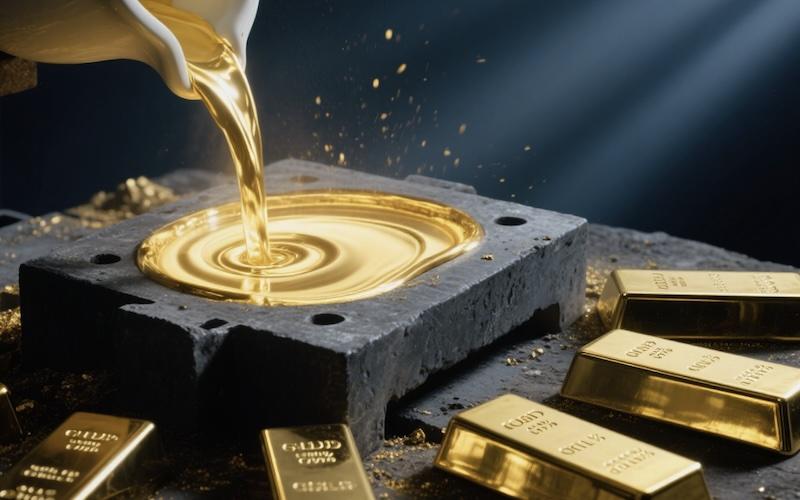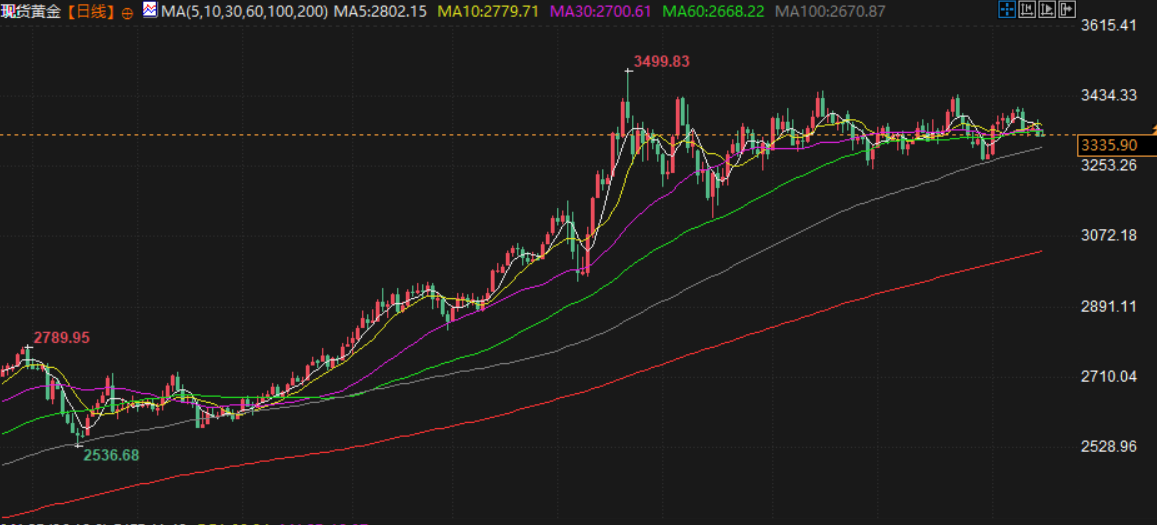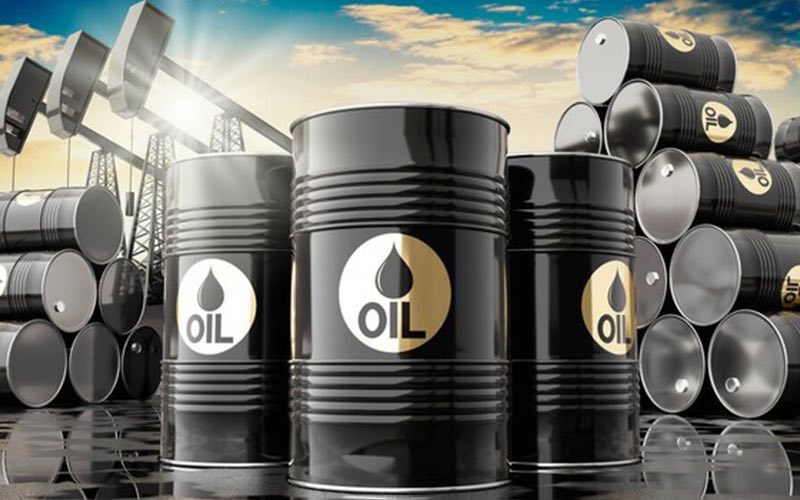Inflationary pressures curbed gold's rebound, uncertainty over the Fed's September rate cut resurfaced, and the Russia-US talks fueled risk aversion.
2025-08-16 08:37:26

Spot gold was little changed at $3,336.66 an ounce, down 1.8% this week. U.S. gold futures settled little changed at $3,382.6.
The U.S. Bureau of Labor Statistics announced Thursday that its producer price index rose 0.9% in July, the largest increase in three years and far exceeding economists' expectations. Trade services inflation, which measures retail and wholesale profit margins, reached 2%, the highest level in several years, potentially suggesting that price increases are being passed on to consumers rather than businesses absorbing them through lower profits.
Analysts say the rise in wholesale prices could be a precursor to higher consumer prices, and that the impact of the Trump administration's tariff hikes has so far been more limited than initially expected.
The data effectively led investors to discount expectations for a 50 basis point rate cut at the Federal Reserve’s Sept. 16-17 meeting. Policymakers will have to decide how to interpret and implement the expected 25 basis point rate cut with inflation well above their 2% target.
Following the PPI report, analysts said they expected the personal consumption expenditures (PCE) price index, excluding the volatile food and energy components, to rise 2.9% year-on-year in July. This is the Federal Reserve's preferred inflation measure. The July PCE report will be released on August 29.
In an interview with CNBC on Thursday, St. Louis Fed President Musallem said that the recent weakness in the labor market has indeed prompted a reassessment of the risks facing the economy. The slowdown in economic growth threatens the job market, and if the weakness persists, an interest rate cut may be necessary. However, he said that given that the inflation rate may be close to 3%, he needs more data before deciding on the policy direction in September. The economy is still in the early stages of adapting to the tariff increase.
"I expect most of the impact of tariffs on inflation to dissipate after two to three quarters, but there is some possibility that these effects may last longer," said Musallem. "We need to understand this better and more data would be helpful."
Richmond Federal Reserve Bank President Barkin said on Thursday that it is still unclear whether the Fed's employment target or inflation target faces greater risks.
“If you do see pressures on both sides, then you always try to ask the question, ‘Is the labor market getting bad enough that it’s going to play a role in holding back inflation?’ In fact, high unemployment is going to drive inflation down,” Barkin said. “Or, is inflation high enough or persistent enough that it’s going to put inflation expectations at risk? I think that’s the trade-off you’re trying to manage.”
The Fed will see the August jobs report and consumer price data before its September meeting, which will be crucial for its rate cut decision and will determine whether the reduction in borrowing costs is described as the start of a rate-cutting cycle aimed at shifting monetary policy toward "neutral" or just an adjustment that may or may not lead to further action in the future.
Investors still see a 25 basis point rate cut in September as a likely outcome, but the probability fell to around 90% from almost 100% after the producer price data.
Before the PPI data was released, U.S. Treasury Secretary Jeffrey Besant said a series of interest rate cuts would be necessary to lower the Federal Reserve's benchmark policy rate from its current range of 4.25% to 4.50% to around 3%, a level considered neither stimulating nor depressing economic activity. The PPI data could complicate the Fed's interpretation of the situation.
While not prejudging the outcome of the September meeting, Mousalem said he believes current economic conditions "do not support" a sharp 50 basis point rate cut, a possibility raised by Bessant earlier this week. San Francisco Fed President Mary Daly echoed that sentiment in an interview with The Wall Street Journal.
Chicago Federal Reserve Bank President Goolsbee, who also has a vote this year, said on Wednesday that while he remains concerned about inflation, he remains open to cutting interest rates in September, but he would be concerned if prices of goods other than those subject to tariffs began to rise faster.
Goolsbee said the rise in service prices in the July Consumer Price Index (CPI) "is the most worrying element in the inflation report," and that if it persists, it will be difficult for us to get back to 2% inflation.
Additionally, weekly jobless claims came in at 224,000, missing expectations of 228,000.
"The move came after U.S. wholesale prices posted their biggest increase in three years in July, suggesting businesses are passing on higher import costs related to tariffs," ANZ said.
"While gold prices stabilized on Friday, they may still face more pressure depending on the outcome of the Alaska summit between Trump and Putin," said Lukman Otunuga, senior research analyst at FXTM.
Trump traveled to Alaska on Friday for a summit with Putin to discuss the Ukraine ceasefire agreement.
The meeting began at around 11:20 a.m. local time on Friday. Trump and Putin did not make opening speeches. Russian presidential press secretary Dmitry Peskov previously said the meeting would likely last six to seven hours.
Previous announcements from both sides indicated that Trump and Putin would initially meet one-on-one, accompanied by an interpreter. However, before the meeting began, the White House informed the media that the small-scale meeting would be changed to a three-on-three format. U.S. Secretary of State Rubio, Middle East Special Envoy Witkov, and Russian Foreign Minister Lavrov and Presidential Assistant Ushakov would also join.
Trump and Putin stepped onto a platform marked "Alaska 2025," shook hands, and posed for photos. They did not respond to questions from the media. They then boarded the presidential limousine to travel to the venue. According to Russian media reports, Putin boarded the armored vehicle at Trump's invitation. This marked the first face-to-face meeting between Russian and US leaders since June 2021 and the first time a Russian president has set foot on US soil since September 2015.
At a joint press conference with Russian President Vladimir Putin, US President Trump stated that the two sides had made significant progress, reaching agreement on many issues and leaving few remaining unresolved issues. However, no agreement was reached on one important issue. He said he would later call Ukrainian President Volodymyr Zelensky, NATO leaders, and other individuals he deemed appropriate to update them on the meeting. Trump expressed hope for good and productive meetings between the US and Russia in the future and expected to meet with Putin again soon. Putin suggested the next meeting might be in Moscow.
According to previous reports, Trump said that if Putin opposes the ceasefire, the United States is considering imposing sanctions on Russian oil companies Rosneft and Lukoil. If the negotiations fail, the United States is considering imposing more tariffs on Russian oil buyers.
"I'm neutral on gold for the coming week," said Colin Cieszynski, chief market strategist at SIA Wealth Management. "There are two big events, today's summit and next week's Jackson Hole conference, that could potentially move the dollar, which could impact gold, but in between, I think the market is likely to be quiet."

- Risk Warning and Disclaimer
- The market involves risk, and trading may not be suitable for all investors. This article is for reference only and does not constitute personal investment advice, nor does it take into account certain users’ specific investment objectives, financial situation, or other needs. Any investment decisions made based on this information are at your own risk.





















